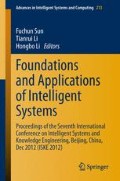Abstract
Collaborative filtering recommender system performs well when there are enough historical data of the users’ online behavior, but it does not work on new users who have not rated any items, or new items that have not been rated by any users, which are called cold-start user and cold-start item, respectively. In order to alleviate the cold-start problem, additional information such as the attributes of users and items must be used. We propose a novel hybrid recommender system, which tries to construct the probabilistic relationship between user attributes and movie attributes using EM algorithm. It can make recommendation for both new users and new items. We evaluate our approach on MovieLens dataset and compare our method with the state-of-the-art approach. Experimental results show that the two approaches have almost the same performance, while our approach uses less time to train the model and make online recommendation.
Access this chapter
Tax calculation will be finalised at checkout
Purchases are for personal use only
References
Linden G, Smith B, York J (2003) Amazon.com recommendations: item-to-item collaborative filtering. Internet Comput IEEE 7(1):76–80
Miller BN, et al (2003)MovieLens unplugged: experiences with an occasionally connected recommender system. In: Proceedings of 8th international conference on intelligent user interface, ACM 2003
Pazzani M, Billsus D (2007) Content-based recommendation systems. In: Brusilovsky P, Kobsa A, Nejdl W (eds) The adaptive web. Springer, Berlin, pp 325–341
Desrosiers C, Karypis G (2011) A comprehensive survey of neighborhood-based recommendation methods. In: Ricci F (ed) Recommender systems handbook, Springer, Berlin, pp 107–144
Hofmann T (1999) Probabilistic latent semantic indexing. In: Proceedings of 22nd annual international ACM SIGIR conference on research and development in information retrieval, ACM
Dempster AP, Laird NM, Rubin DB (1977) Maximum likelihood from incomplete data via the EM algorithm. J R Stat Soc Ser B (Method), 1977:1–38
Hofmann T (2001) Unsupervised learning by probabilistic latent semantic analysis. Machine Learn 42(1):177–196
Park ST, Chu W (2009) Pairwise preference regression for cold-start recommendation. In: Proceedings of the 3rd ACM conference on recommender systems, ACM
Schein AI, et al (2002) Methods and metrics for cold-start recommendations. In: Proceedings of the 25th annual international ACM SIGIR conference on research and development in information retrieval, ACM
Manning CD, Raghavan P, Schutze H (2008) Introduction to information retrieval, Vol 1. Cambridge University Press, Cambridge
Sarwar B, et al (2001) Item-based collaborative filtering recommendation algorithms. In: Proceedings of the 10th international conference on world wide web, ACM
Shardanand U, Maes P (1995) Social information filtering: algorithms for automating “word of mouth”. In: Proceedings of the SIGCHI conference on human factors in computing systems
Herlocker JL, Konstan JA, Borchers A, Riedl J (1999) An algorithmic framework for performing collaborative filtering. In: Proceedings of the 22nd annual international ACM SIGIR conference on research and development in information retrieval
Koren Y, et al (2009) Matrix factorization techniques for recommender systems. Computer 42:30
Jamali M, Ester M (2010) A matrix factorization technique with trust propagation for recommendation in social networks. In: Proceedings of the 4th ACM conference on recommender systems RecSys’10, ACM
Yehuda Koren. Collaborative filtering with temporal dynamics. In: Proceedings of the 15th ACM SIGKDD international conference on knowledge discovery and data mining, Communications of the ACM
Zhou K, Yang SH, Zha H (2011) Functional matrix factorizations for cold-start recommendation. In: Proceedings of the 34th international ACM SIGIR conference on research and development in information retrieval, ACM
Rashid AM, et al (2002) Getting to know you: learning new user preferences in recommender systems. In: Proceedings of the 7th international conference on intelligent user interfaces, ACM
Golbandi N, Koren Y, Lempel R (2011) Adaptive bootstrapping of recommender systems using decision trees. In: Proceedings of the 4th ACM international conference on web search and data mining, ACM
Golbandi N, Koren Y, Lempel R (2010) On bootstrapping recommender systems. In: Proceedings of the 19th ACM international conference on information and knowledge management, ACM
Popescul A, et al (2001) Probabilistic models for unified collaborative and content-based recommendation in sparse-data environments. In: Proceedings of the 17th conference on uncertainty in artificial intelligence
Gantner Z, et al (2010) Learning attribute-to-feature mappings for cold-start recommendations. In: Data mining (ICDM) 2010 IEEE 10th international conference
Acknowledgments
This paper was supported by the Science and Technology Innovation Action Plan (Grant Number:12511502902) of Shanghai Science and Technology Committee.
Author information
Authors and Affiliations
Corresponding author
Editor information
Editors and Affiliations
Rights and permissions
Copyright information
© 2014 Springer-Verlag Berlin Heidelberg
About this paper
Cite this paper
Wang, G., Wang, Y. (2014). Probabilistic Attribute Mapping for Cold-Start Recommendation. In: Sun, F., Li, T., Li, H. (eds) Foundations and Applications of Intelligent Systems. Advances in Intelligent Systems and Computing, vol 213. Springer, Berlin, Heidelberg. https://doi.org/10.1007/978-3-642-37829-4_36
Download citation
DOI: https://doi.org/10.1007/978-3-642-37829-4_36
Published:
Publisher Name: Springer, Berlin, Heidelberg
Print ISBN: 978-3-642-37828-7
Online ISBN: 978-3-642-37829-4
eBook Packages: EngineeringEngineering (R0)

